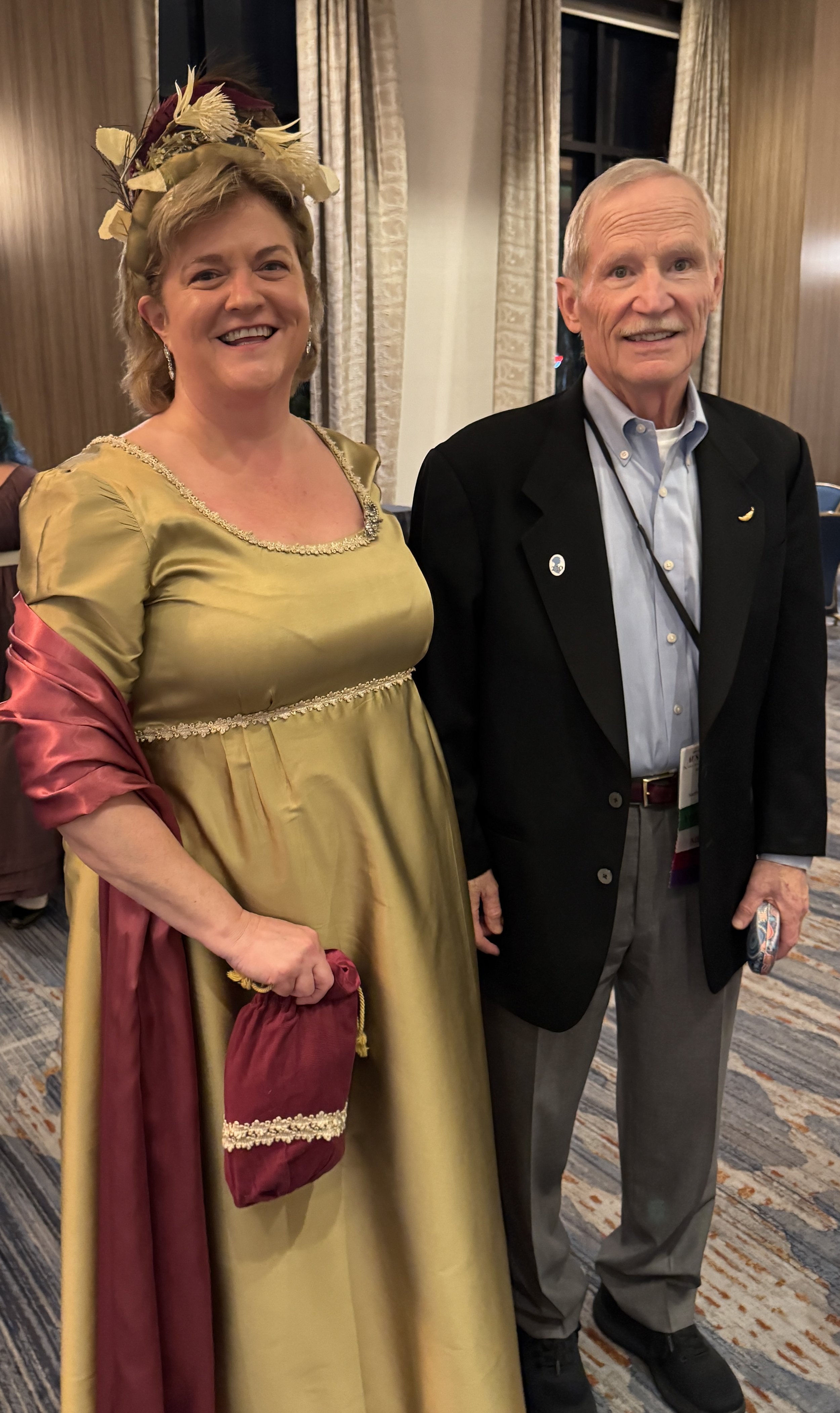Austen's 250th Celebration Marked with Energy, Study
Baltimore’s recent annual general meeting (AGM) of the Jane Austen Society of North American (JASNA) celebrated Austen’s 250th birthday coming up December 16. The AGM was full of sound and fury, signifying a great deal. Well, maybe not fury, but energy. Lots of it. And great scholarship. All on the topic of the genius of Austen.
At 950 attendees, it is believed to be the largest JASNA gathering in history. Some 200 were first-timers. Many were younger people, a good thing for an organization skewing older. Another 225 people attended by livestream. Ten countries were represented, with another four participating by streaming. It was announced that an Austen society is forming in France. The annual essay contest drew 560 entries from 45 countries. Lots going on!
Attendees included eight Janes and one Wentworth, a vigorous fourteen-month-old boy who happened to be staying with his parents in the hotel room next to mine. Like any worthy Austen hero, Wentworth never fussed too late at night.
Serious panel on the genius of Jane Austen finds a lighter moment. L to R, Susan Allen Ford, Janine Barchas, Inger Brody, Collins Hemingway, Devoney Looser.
Along with a full bank of breakout sessions in which presenters have competing timeslots, this AGM somehow crammed in a couple of extra plenary sessions before the entire group. I participated in a plenary panel featuring Austen luminaries Janine Barchas, Inger Brody, and Devoney Looser. We each had five minutes to explain Austen’s genius.
Luminary Susan Allen Ford, editor of JASNA’s Persuasions journal, served as moderator and took questions from attendees and viewers. Not sure anyone can fully capture Austen’s genius in five minutes or five years, but we tried. And had a lot of fun.
There were too many sessions to highlight fully, so here are a few that jumped out at me:
Rebecca Romney spoke about early women writers who influenced Austen. She talked not only as a reader discovering new works and connections to Austen’s novels but also as a rare book collector. Much of the context was how “format has an impact on content”—whether that’s Austen produced as a cheap modern paperback done up as a romance novel or an ancient, fragile first edition.
Caroline Jane Knight, who was the last person to grow up in the Great House at Chawton, gave a personal account of life there as a young person. Caroline is Jane Austen’s fifth great-niece via brother Edward. By her time, the family had struggled for generations to keep the house and estate functioning. She brought and discussed family heirlooms, including items Jane mentioned in her letters.
Caroline Jane Knight, a collateral Austen descendant, spoke of her life growing up in the Great House at Chawton.
Chawton House, where Jane sometimes wrote or studied, is now a library for early women writers with numerous online and in-person educational programs. You can support it through the North American Friends of Chawton House.
Juliette Wells spoke about her literary detective work trying to identify the small portrait of Mrs. Bingley (Jane Bennet of Pride and Prejudice) that Austen humorously wrote of seeing at a painting exhibition in London. In a May 1813 letter to her sister Cassandra, Jane said that the portrait looked “excessively like her” and described the white gown with green ornaments she wore. The outfit, she said, confirmed her belief that green was Jane Bennet’s favorite color.
Wells so far has not identified the actual painting referenced, but she was able to rule out for historical or other reasons several paintings that have been proposed in the past.
The last two talks that drew my special interest (for all that I saw were interesting) both involved details from Austen’s novels and what they reveal about her approach to writing. That was also the point of my presentation, which I began by pointing out her enthusiasm for the placename Newton-Priors, created by her niece Anna Austen when Anna was trying her hand at novels. Jane thought that Newton-Priors was a perfect name for a village and encouraged Anna to be that precise with all details.
One precision-focused talk was Paula Byrne’s about Austen’s use of mirrors to reveal character. Her title, “Looking-Glasses at Odd Corners,” comes from a comment by Virginia Woolf that novels must hang up mirrors at “odd corners” to get a glimpse at reality.
John Mullan’s closing plenary focused on the “minuteness” of Jane’s genius, emphasizing her word choice and her invention of new words and phrases—at least twenty by his count including the seemingly ordinary “coffee urn” and “dessert-spoon” and the less ordinary “donkey-carriage.”
The only thing missing from the wonderful event was the Saturday evening promenade of attendees in Regency dress. This walk, often winding through the hotel and even out onto nearby streets, was restricted to the stage last year. In 2025, nada. A shame, as both dressers and audience find this the most charming aspect to every AGM.
---
If I may be allowed a one-time listing of a non-Austen book, I'm proud to announce the release of Running Against the Wind: A Black Arkansan's Pursuit of His Dream. The book is both a biography of a person--a high school classmate of mine--and a chronicle of Black life in America today. It is available here on Amazon.
My other new book, Jane Austen and the Creation of Modern Fiction: Six Novels in “a Style Entirely New,” investigates her development as a writer and shows how her innovations as a prose stylist set the course for modern fiction. It is available from Jane Austen Books at a special low price.

